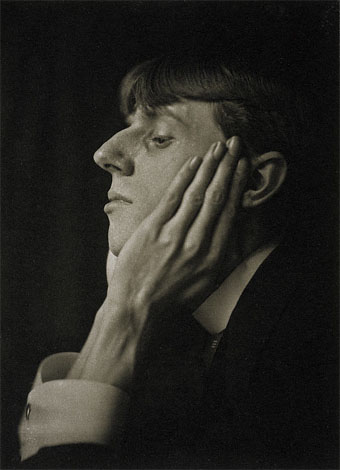
Aubrey Beardsley photographed by Frederick Evans (1894).
I’ve been going through the Coulthart VHS library recently, transferring to DVD recordings which can’t be purchased or found online. Among these is a drama from the BBC’s Playhouse strand, Aubrey by John Selwyn Gilbert, which was broadcast in 1982. This drama follows the life of artist Aubrey Beardsley from the time of Oscar Wilde’s arrest in April 1895—which event resulted in Beardsley losing his position at The Yellow Book—through the foundation of The Savoy magazine, to his tubercular death in March 1898.
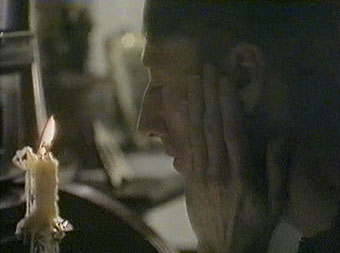
John Dicks as Aubrey.
Playhouse was a BBC 2 equivalent of Play for Today (which usually ran on BBC 1) and Aubrey, like many other dramas of the period, was shot on video in the studio. This was done for convenience as well as being cheaper than shooting on film, since scenes could be filmed using several cameras simultaneously. The drawback is that the image looks very harsh, and historical works such as this often seem unreal and artificial as a result. If you can forgive this deficiency, Aubrey was an excellent production with some great performances, especially Ronald Lacey as Leonard Smithers and Rula Lenska as Aubrey’s sister, Mabel. The details of Beardsley’s life are very accurate, down to his beloved Mantegna prints on the walls, and many of the scenes are arranged to correspond with his drawings, the production design being largely monochrome.
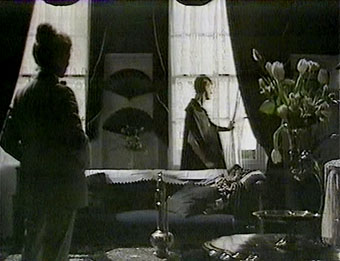
Rula Lenska and John Dicks.
Despite the limited production, the mise-en-scene presents carefully framed shots like the one above which create Beardsley-like compositions. Geoff Powell was the production designer and Peter Hammond the director. Hammond later directed several of the Sherlock Holmes adaptations for Granada TV. Producer Rosemary Hill had previously produced some of the BBC’s ghost story adaptations which have acquired a cult reputation in recent years.
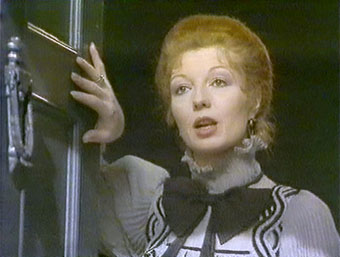
Rula Lenska is ideal as Mabel Beardsley, John Dicks less so as Aubrey although his aquiline profile certainly matches that of the artist. In many scenes he seems simply too robust and healthy and he’s also conspicuously too old (he was 35 at the time) to be playing a man of 22. Gilbert agrees with a number of Beardsley’s biographers that there was an incestuous component to Aubrey and Mabel’s relationship, and this is dramatically demonstrated in a later scene.
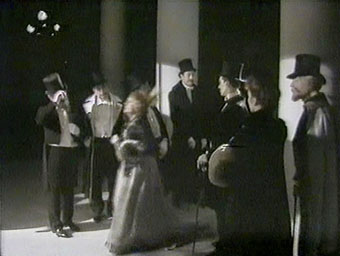
One of the many visual quotes. Just before Aubrey arrives at a theatre to see a Wagner performance we see this moment based on Lady Gold’s Escort.
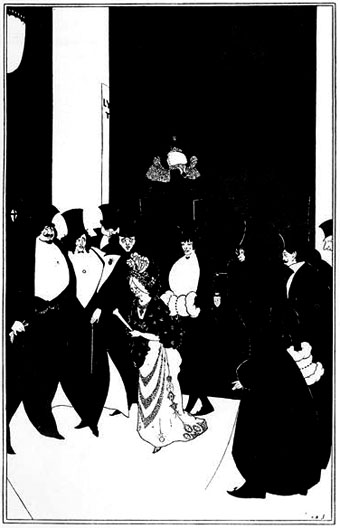
Lady Gold’s Escort from The Yellow Book (1894).
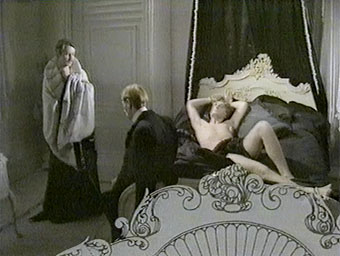
Turned away from the theatre for his perceived association with the now disreputable Wilde, Aubrey goes to visit André Raffalovich and John Gray. Raffalovich and Gray were no friends of Wilde (nor he of they) but the wealthy Raffalovich supported Beardsley through some lean times. Raffalovich is played here by Sandor Elès (left). When he turns around at the end of the scene he reveals the design of Beardsley’s Peacock Skirt on his dressing gown.
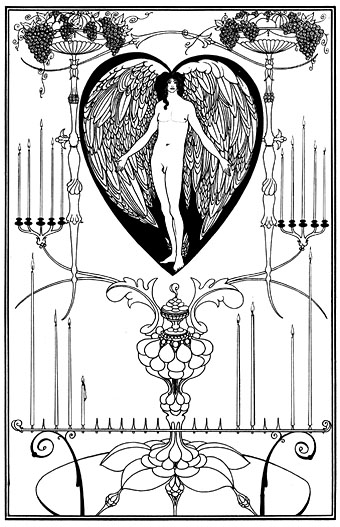
The Mirror of Love (1895).
Beardsley produced a frontispiece, The Mirror of Love, for The Thread and the Path, a collection of Raffalovich’s poems but the drawing was rejected by the publisher for its allegedly “hermaphrodite” figure.
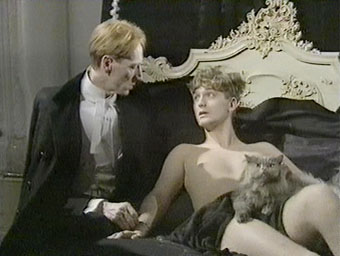
Raffalovich and Gray were a gay couple, of course, and their scene has Simon Shepherd as John Gray doing a great deal of lusciously languid posing on the black sheets.
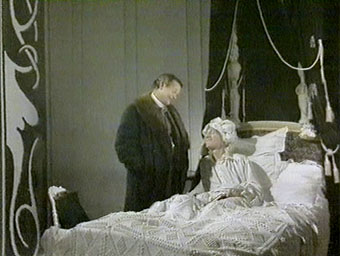
In a later bedroom scene Beardsley and Leonard Smithers meet for the first time, with the bed modelled on the (imaginary) one seen in Portrait of Himself.
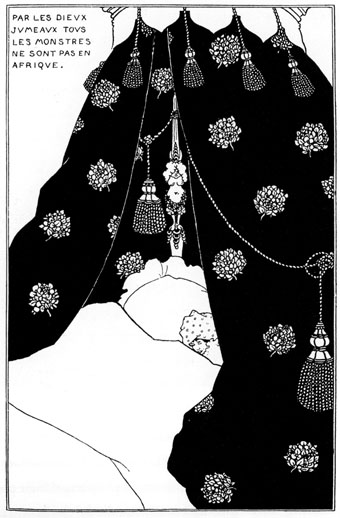
Portrait of Himself from The Yellow Book (1894).
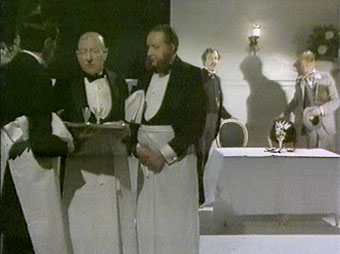
Another quote: Arthur Symons and Beardsley planning The Savoy magazine in France with a trio of waiters borrowed from Garçons de Café.
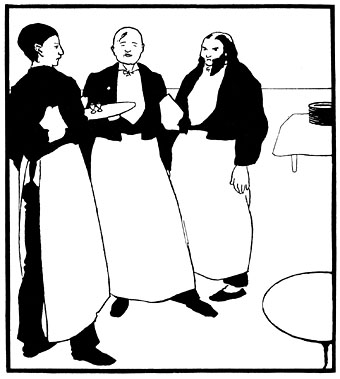
Garçons de Café from The Yellow Book (1894).
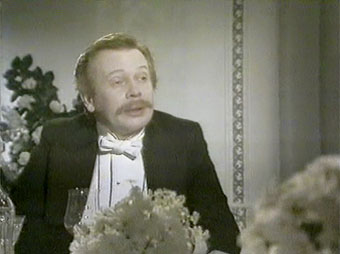
Ronald Lacey again as Smithers, the pornographer publisher about whom Oscar Wilde said:
His face, clean shaven as befits a priest who serves at the altar whose God is Literature, is wasted and pale—not with poetry, but with poets, who, he says, have wrecked his life by insisting on publishing with him. He loves first editions, especially of women: little girls are his passion. He is the most learned erotomaniac in Europe. He is also a delightful companion and a dear fellow…
In this scene we see the publisher and contributors of The Savoy celebrating the appearance of the first number at the New Lyric Club. The magazine ran for eight issues and was banned by WH Smith’s. Part of the reason for the magazine’s failure was that this embargo prevented it being sold at railway station stands owned by Smith’s.
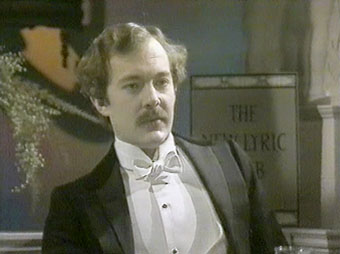
Christopher Strauli as Arthur Symons, The Savoy‘s literary editor, and an actor I always associate with Bunny Manders, the role he played in earlier TV adaptations of Raffles.
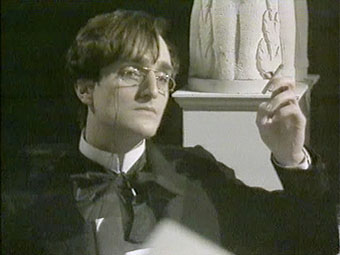
Mark Tandy as WB Yeats.
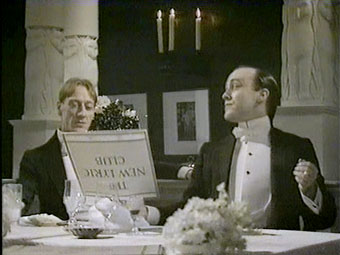
Alex Norton (right) as Max Beerbohm, showing Aubrey a caricature he’s just drawn of Yeats. Beerbohm caricatured Beardsley on several occasions, and later satirised the “Yellow Nineties” in his wonderful short story Enoch Soames, so it’s perhaps fitting to end with one of Beerbohm’s drawings.
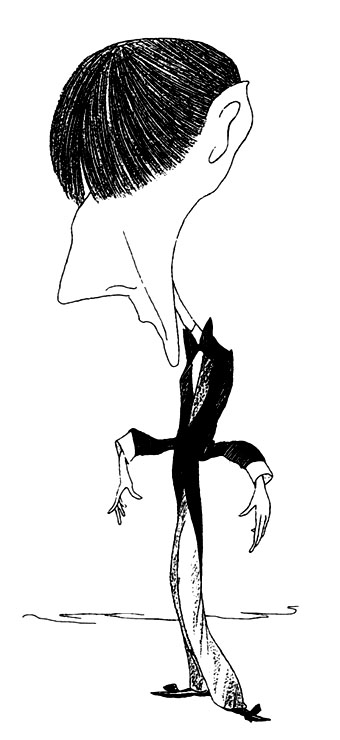
Aubrey Beardsley by Max Beerbohm (1894).
NB: I’ve no idea where or how you’d be able to see Aubrey for yourself and I certainly won’t be distributing copies so please don’t ask for one. Thanks. Anyone desperate to see it is advised to petition the BBC.
Elsewhere on { feuilleton }
• The Aubrey Beardsley archive
• The illustrators archive

How incredibly fabulous!
And though he may not have been the ideal actor for the role, by virtue of his name alone I’m sure Beardsley would have approved!
(I was referring to Dicks, of course! As one so often is…)
Yes, Dicks’ name would certainly have pleased Aubrey the phallic obsessive.
Too bad. I would have loved to see the movie.
This looks wonderful, especially the casting. I wonder if the BBC might not eventually release it on DVD; after all they released those ghost stories produced by Rosemnary Hill, and wasn’t there some talk recently of their releasing all their back catalogue online?
Incidentally, since you mention the possible incestuous aspect of Beardsley’s relationship with his sister, did you know that there was someone going around artistic circles in the 1920s (I think), claiming to be their offspring? I’m afraid I an;t even remember what sex they were, but I remember seeing a portrait of a person who looked exactly as you would imagine their child to look in an exhibition at the V&A about ten years ago.
The BBC has hours and hours of stuff like this, most of it only ever screened once, as Aubrey was. The question of what they do with all of it is always fraught. You’ll only get a fraction of things reissued on DVD since they only try that with things which are likely to sell and they also have to track down actors and pay them fees. Their plans to upload things have been compromised for now by the iPlayer which many people dislike.
Stephen Calloway refers to the supposed son of Aubrey and Mabel, aka “Mr Watkins”, in his 1998 biography. He includes the picture which he says is actually a portrait of illustrator Alan Odle (with Beardsley drawings on a wall behind him) painted by one Adrian Allanson. The portrait dates from around 1914 but the rumour only surfaced in 1966 when the V&A had their big Beardsley exhibition.
“Mr Watkins” rings a faint bell, but I have a vague feeling that the person was female, and I’m pretty certain they were described as claiming (falsely) to be the child of the two Beardsleys. I’ve spent some time trying to scare up a copy of the picture I remember, but the internet has failed me so far.
Good to see director Peter Hammond get a name check. I’ve thought for about 20 years that he was the most visually interesting director in British television. (I’ve even sat through episodes of ‘Morse’ because they were directed by PH!) If he had worked in Italy or France, I’m sure he would be revered as a master ‘metteur en scene.’ Unfortunately, he only got to direct one theatrical feature, ‘Spring and Port Wine’, which has a great cast but barely transcends its origins as a stage play, presumably because of budget limitations. I would love to see a comprehensive season of Hammond’s work at the NFT; in the meantime, the feature-length Sherlock Holmes episode, The Master Blackmailer, is a good example of Hammond’s exquisite eye for composition.
Yes, TV directors do tend to get short shrift. I also rate Alan Clarke, about whom I’ve been planning a lengthy post similar to this one, and Leslie Megahey who directed the celebrated adaptation of Schalken the Painter and many great arts films and documentaries for Arena and Omnibus.
I saw Mark Tandy about 20 years ago in The Importance of Being Earnest. I think he played Earnest.
I do have some vague memories of seeing ‘Aubrey’ when it was first broadcast. I have been an admirer of Beardsley ever since I discovered a copy of ‘The Later Works of Aubrey Beardsley’ in the school library back in the sixties. Since then my interest in the artist has grown and I have read several biographies. I would absolutely love to see the drama again and will follow your advice and make contact with the BBC to ask for it to be shown again.
Hi Jennifer. I imagine some kind of streaming via the iPlayer or its future equivalent will be the way these dramas receive a new airing. Not very satisfactory but there are so many things like this–all those Plays For Today for a start–that it’s hard to imagine them going to the expense of putting out individual DVDs.
In 1982, when ‘Aubrey’ was transmitted, it was linked on BBC2 with a full length documentary, ‘Beardsley and his Work’, which I also wrote and which I produced and directed myself.
In it, Ralph Steadman and others discussed the techniques Beardsley used for creating his illustrations and the ways in which Smithers and others reproduced them for publication. Bill Morton commissioned the documentary which, taken together with the play, combined as much technical, biographical, historical, psychological and art-historical information about Beardsley as I could uncover in the nine years (1972-81) that it took me to put the two programmes together.
During this period, I had the unusual privilege of carefully scrutinising all the Beardsley originals in the Victoria and Albert Museum and in some of the American collections. Ralph Steadman also scrutinised many of them and came to the surprising conclusion that Beardsley was using a brush (not just pen and ink) in a number of the pictures, especially those for the Morte d’Arthur. To my surprise, not many commentators seem to have noticed this small revelation which showed up clearly in ultra close ups of the originals shown in my documentary.
Technicalities aside, it is Beardsley’s tormented relationship with sexuality that drives his art. I know of almost no other artist whose line, whose actual line, conveys so much sensuality and frustrated lust. And why frustrated? Perhaps for two reasons – that his sister attracted him in ways that he recognized as transgressive and that his physical weakness from the early symptoms of tuberculosis precluded or very much discouraged physical expression. Orgasm might have caused a haemorrhage which would kill him. An orgasm on the page was much safer than one in real life for a very weak, sickly (and hugely talented) young man, cursed with all the desires of adolescence and no normal physical means of expressing them.
It is a sad story – or at least I found it so. I told it in two different ways, in two different forms, but always with fascination and, I hope, compassion. Beardsley’s pictures are still wonderful to me. They are still just as striking, however many times I see them. I am very pleased that the play has justified your attention more than 30 years after I started working on it but don’t forget about the documentary (which is even more interesting) and I would, of course, be altogether delighted if you could band together to persuade the BBC to re-issue both of these programmes on DVD.
Hi John and many thanks for taking the time to comment. I actually have the documentary on tape although in less-than-ideal form since it was a copy of a copy and I think the beginning is missing. But still good to see Beardsley aficionados such as Brian Reade and Brigid Brophy discussing the works. I should obviously watch it again since I’d forgotten the Steadman comment about the brush work. That makes sense to me since much of the line work for those early pictures is thicker than Beardsley’s later fine-line style.
I don’t hold out much hope for the BBC doing anything with these and other works apart from (maybe) letting them stream online one day in the distant future. I mentioned the films of Alan Clarke above; his TV plays are held in huge regard, they’ve influenced American directors and featured actors who are now big names. Yet the BBC has never reissued anything of his, it took a small DVD company to put together a box of some of his work. Small companies may be the key to getting some of this material back into the world although for the time being that possibility seems equally remote.
I liked Alan Clarke and respected his work a great deal. But the BBC moves in mysterious ways (and always did). Still, I am glad the Beardsley documentary is known to you. The play and the documentary would make an interesting package on DVD and it is about time for a (nother) Beardsley revival. All the best, jsg
I have this on video somewhere, & now I shall not rest to-night until I find it. Mine is a gawd-awful print, faded and jerky; but I love the film so much. I found your vlog because I’ve been posting Beardsley YouTube videos on my Facebook timeline tonight, and I thought there was footage from this BBC production at YouTube. Then I did a search to see if the film was available as dvd. I am going to pay tribute to Aubrey is the Lovecraftian novelette I am beginning to outline.
The documentary was placed on youtube in 2011:
http://www.youtube.com/watch?v=5naWuIWmpIU
Fascinating!
Hi Dominique. I hadn’t noticed that, many thanks!
I am really glad someone has put the documentary up on YouTube – it was probably the best film I ever made. I think it has got stretched to wide screen at some stage, which means the compositions are not quite as I intended but who cares …. it can still inspire people to go look at Beardsley’s work again.
I wrote the film’s script and also produced and directed it. I got an actor in to read my commentary and he was a good actor. He did it very well.
When the late Bill Morton, who commissioned the film, heard the version with the actor’s commentary he then asked me to record the commentary myself.
He had heard me read it many times at rough cut stage. I suppose he wanted me to read it because of the intensity which I still detect in my voice.
Beardsley’s work meant (and means) a great deal to me. It moves me. I am not quite sure why. He knew he was going to die, that he had very little time. There is a desperation about his art.
I also suffered from tuberculosis when I was young. I would have died in my twenties, as Beardsley did, were it not for penicillin.
Next year, I will be seventy. Yesterday, I heard that I will have a fourth grandchild to help celebrate my birthday.